We have moved to The Furious Panda! Check out our new home =)
Furious Panda
My travel blog - in which I attempt to share my trip tales!
Friday, March 04, 2011
Sunday, February 27, 2011
Day 4 – Rajshahi division, Hello and Farewell in a Day
Date: 06 Feb 2011
Location: Hotel Victory, Dhaka
The plan for today was impromptu. The initial plan was to go back to Dhaka and spend two more days there, doing a day trip out to the Sonargon on day 5. But as usual, the travel lust in me sets in, and the daft adventurer in me decides on an elaborate plan to hit northwards towards Rajshahi by train, then taking a local bus from there to Bogra. And going out to Mahasthangarh, the oldest city in Bangladesh, ruins built in the 3rd century, before returning to spend the night in Bogra. On day 5, I would wake up at dawn and make my way by bus to Paharpur, the launch point to Sompuri Vihara, the 3rd and final UNESCO site here in Bangladesh. Then I would rush back to Bogra by lunch and take the 6 hour bus ride into Dhaka, ending a 5 day blitz through Bangladesh with a flurry of a finale.
But as usual, the best laid plains go awry. As i am writing this at the end of Day 4, I sit in a a hotel room in Dhaka, holed up and awaiting tomorrow's hartal. Hartal? What the heck is a hartal you say?! Ok, to explain further how I ended up here, we need to go back to the start of today.
The day started off reasonably uneventful. Early morning at 530am, I left my lodging and walked towards the train station, since there were no rickshaws out and about this early in the morning. The Khulna train station was crowded, and the Intercity train was parked by the platform, ready to set off around 7. Other than a smart-ass local who leeched a second cup of tea off me when I ordered mine, yes, somehow everywhere I go there's also these kinds of over-zealous idiots who tries to make friends with some hidden motive, it was a quiet morning.
At the platform, I met Halim Nazrul, who works in the pharmaceutical industry. Everyone here who speaks decent English, is a degree holder from one of the many universities in the country. Most I spoke to even had MBAs. But here, in a country of more than 150 million people with the highest population density in the world (excluding tiny city states like Singapore of course) and where poverty is widespread, a good education does not necessarily lead to a good job and high pay. Heck, even Karim, the Bangla cleaning guy in my office, has a general degree, yet he moved to Singapore to slog for a few years, earning much more than he would in the same time back home.
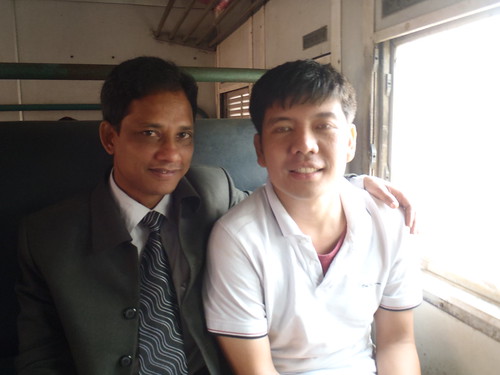
Ok back to Halim, I try to impress him with my 3 days worth of Bengali by pointing out the Bangla numbers printed above the carriages, and asking him which one corresponds to my ticket number. We speak, and he genuinely was excited at meeting a foreigner from Singapore, and a tourist at that. We board the train, and head towards my carriage. I find that instead of the private cabins on first class, where you have 4 to a cabin, my ticket leads me to sulob class, which is still in the 1st class carriage, but comprise two long cushioned benches facing each other. There was one other old guy whose name i did not catch, in the chair opposite me, and the next two hours were spent talking to Halim and the old guy. Well, more Halim because the old guy doesn't speak much English and Halim had to act as translator whenever the former asked me anything. Actually, I was quite thankful for the old guy, for he provided a respite when I needed a break. Earnest Halim would leave me alone for a while and talk to old guy instead.
The train ride was recommended by those exchange students at Grameen Bank i met yesterday, which influenced my decision to go north. By now, I had taken an impressive variety of tranport on this trip. There's the plane into Dhaka, the rickshaws, the CNG tuk-tuks, the shared tempos, cabs, a Rocket steamer, the Sundarbans boat, public buses, this inter-city train, and later on i would top up my list with the infinitely more comfortable bus coaches.

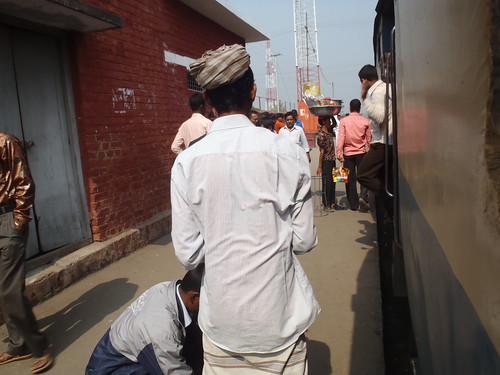
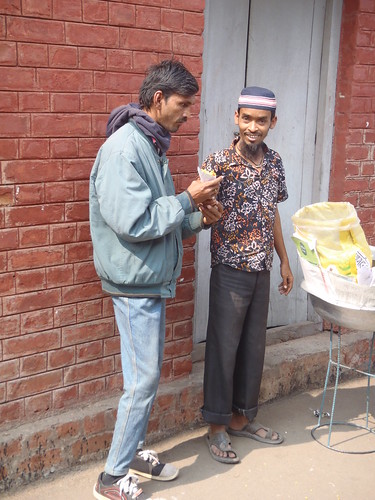
The intercity train stops at each town and city along the way, hence its name. At each stop, vendors would walk up and down selling their wares through the train windows. Halim and the old guy alighted two hours into the journey, leaving me with my posse of fans and hangers-on who had crowded around my seating area, eager to find out more about the foreigner. I am honoured from all the attention given, and continued to talk with them, but after a while, it can be exasperating trying to converse with my barely there Bangla and their barely there English, especially when all I wanted to do was take a nap. I shifted to the window seat and promptly fell asleep leaning against the window, only waking up when I reached Rajshahi, the last station.
Rajshahi is a university town, the Rajshahi university is one of the major landmarks in the city, and young university students flock the streets around campus. I did not spend any time there, preferring instead to get on the Bogra bus immediately. It was 1pm. I passed by the university though, and outside was a famous memorial statue commemorating the independence of 1971, from Pakistan. Here's an article i picked out from the local tabloid summarising the painful history of the country.
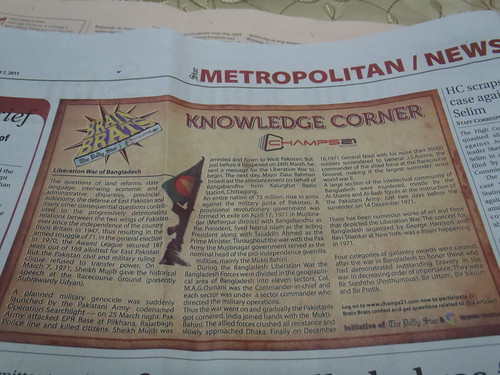
Another interesting fact is that 21st february is International Mother Language Day, which celebrates the mother tongues of each country. This day originated in Bangladesh where, in the struggle for independence, some protesters were killed when they refused to adopt Urdu as per Pakistan as the national language, instead keeping to Bangla. This day was later incorporated into the International Mother Language day we know today.
Hmmm. Conversation with Halim back on the train also led to languages, specifically, why despite both Singapore and Bangladesh being former British colonies, the usage of English is Singapore was so widespread but in Bangladesh, only a smattering of people spoke English fluently. Welll, according to Halim, the reason is because during the period of British rule, the Muslims in Bangladesh refused to learn or practise English, while the Hindus were the only ones who picked up the language.
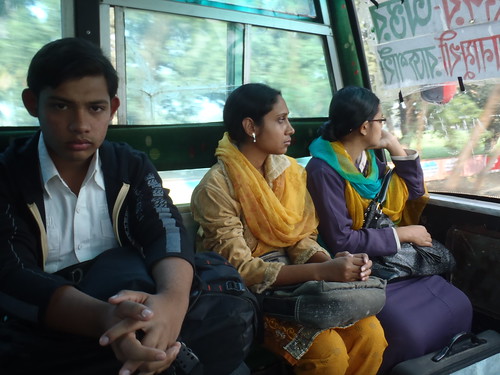
Going on, the two hour Bogra bus actually took three hours. Packed, as usual I was shepherded to the front of the bus, where some university student types can be found, and invited to sit with a certain M.A.Matin, who from the sound of his name, as well as his features, would be a Hindu. Mr Matin is a teacher, and he is going back to Bogra carrying a brand new desktop bought in Rajshahi, tucked tightly on the floor between his legs, for his daughter. He is a pretty quiet man, (and for that I am thankful), but we do talk, and he shows me some black and white stills that he has just printed and bringing back to his school for an exhibition. The said photos show very disturbing shots of the previously mentioned 1971 Bangladesh Liberation War: bodies on the ground, gaunt corpses, soldiers with weapons, and the like.
It was on further conversation with Matin, however, that made me realise that I won't be able to complete my itinerary. Apparently, Feb 7, tomorrow is the day of a country-wide hartal, or strike. Organised by the opposition party BNP, it is to protest against the rising food prices, and the government plans to build a brand new airport near Dhaka. During this strike, he said, protesters would demonstrate peacefully in various cities and hotspots around Bangladesh (like universities!!). How he knew this? Apparently, hartals such as these were common, the last one being back in November. Such hartals cripple the country and economy, whether they actually achieved their purpose is questionable.
During one of these hartals, all shops will be closed, and all transport on the street will stop. It would probably be the only time when Dhaka's streets will be free of the daily jam, i thought to myself. Any cars or buses found on the street run the risk of getting stoned, vandalised and maybe even set alight by demonstrators. The rickshaws would obviously be the exception, for no one really bothers with them. What a fix to find myself in, i mean, what are the odds of me hitting a strike day during a 5 day visit (well, yeah, these strikes ARE commonplace here, but still!).
I looked in my local papers, and with a sigh, saw an article which confirmed what Matin said. There was no way I would be able to find a public bus into Dhaka tomorrow. It left me no choice, I will have to forego all other plans, and from Bogra, take the next bus out to Dhaka. If only they postponed the hartal by a day or something, then I could complete all the sights as planned. Well, time to adapt as necessary.It was 430pm, and the bus ride is 6 hours. I booked the 6pm coach, from the many coach companies that ply the Bogra-Dhaka route. Took my first proper meal for the day (i love the salt, it is the main condiment here, and i read somewhere they add something into the salt to make it very tasty, something like Ajinomoto or MSG), and proceeded to wait for coach to set off.

Actually, there is a bit of schadenfreude here, I am silently anticipating how the strike would turn out tomorrow. Reaching Dhaka at around 1am, I paid an exorbitant amount for a CNG to take me to Hotel Victory, located in the heart of Dhaka, Motijheel. Since I was going to be stuck the entire day in the hotel tomorrow, I decided to dispense with the 2 dollar hotels of the past few days, and splurge on a 30-40 USD room with aircon, cable tv, comfy beds and an internet connection. It was dark as I walked around the corner where the CNG dropped me off, to Hotel Victory. Little did I know that the nondescript building beside Hotel Victory was actually the main office and center of operations for BNP, the opposition party which instigated tomorrow's hartal.
Next entry: 7th Feb, hartal in Dhaka!
Location: Hotel Victory, Dhaka
The plan for today was impromptu. The initial plan was to go back to Dhaka and spend two more days there, doing a day trip out to the Sonargon on day 5. But as usual, the travel lust in me sets in, and the daft adventurer in me decides on an elaborate plan to hit northwards towards Rajshahi by train, then taking a local bus from there to Bogra. And going out to Mahasthangarh, the oldest city in Bangladesh, ruins built in the 3rd century, before returning to spend the night in Bogra. On day 5, I would wake up at dawn and make my way by bus to Paharpur, the launch point to Sompuri Vihara, the 3rd and final UNESCO site here in Bangladesh. Then I would rush back to Bogra by lunch and take the 6 hour bus ride into Dhaka, ending a 5 day blitz through Bangladesh with a flurry of a finale.
But as usual, the best laid plains go awry. As i am writing this at the end of Day 4, I sit in a a hotel room in Dhaka, holed up and awaiting tomorrow's hartal. Hartal? What the heck is a hartal you say?! Ok, to explain further how I ended up here, we need to go back to the start of today.
The day started off reasonably uneventful. Early morning at 530am, I left my lodging and walked towards the train station, since there were no rickshaws out and about this early in the morning. The Khulna train station was crowded, and the Intercity train was parked by the platform, ready to set off around 7. Other than a smart-ass local who leeched a second cup of tea off me when I ordered mine, yes, somehow everywhere I go there's also these kinds of over-zealous idiots who tries to make friends with some hidden motive, it was a quiet morning.
At the platform, I met Halim Nazrul, who works in the pharmaceutical industry. Everyone here who speaks decent English, is a degree holder from one of the many universities in the country. Most I spoke to even had MBAs. But here, in a country of more than 150 million people with the highest population density in the world (excluding tiny city states like Singapore of course) and where poverty is widespread, a good education does not necessarily lead to a good job and high pay. Heck, even Karim, the Bangla cleaning guy in my office, has a general degree, yet he moved to Singapore to slog for a few years, earning much more than he would in the same time back home.

Ok back to Halim, I try to impress him with my 3 days worth of Bengali by pointing out the Bangla numbers printed above the carriages, and asking him which one corresponds to my ticket number. We speak, and he genuinely was excited at meeting a foreigner from Singapore, and a tourist at that. We board the train, and head towards my carriage. I find that instead of the private cabins on first class, where you have 4 to a cabin, my ticket leads me to sulob class, which is still in the 1st class carriage, but comprise two long cushioned benches facing each other. There was one other old guy whose name i did not catch, in the chair opposite me, and the next two hours were spent talking to Halim and the old guy. Well, more Halim because the old guy doesn't speak much English and Halim had to act as translator whenever the former asked me anything. Actually, I was quite thankful for the old guy, for he provided a respite when I needed a break. Earnest Halim would leave me alone for a while and talk to old guy instead.
The train ride was recommended by those exchange students at Grameen Bank i met yesterday, which influenced my decision to go north. By now, I had taken an impressive variety of tranport on this trip. There's the plane into Dhaka, the rickshaws, the CNG tuk-tuks, the shared tempos, cabs, a Rocket steamer, the Sundarbans boat, public buses, this inter-city train, and later on i would top up my list with the infinitely more comfortable bus coaches.



The intercity train stops at each town and city along the way, hence its name. At each stop, vendors would walk up and down selling their wares through the train windows. Halim and the old guy alighted two hours into the journey, leaving me with my posse of fans and hangers-on who had crowded around my seating area, eager to find out more about the foreigner. I am honoured from all the attention given, and continued to talk with them, but after a while, it can be exasperating trying to converse with my barely there Bangla and their barely there English, especially when all I wanted to do was take a nap. I shifted to the window seat and promptly fell asleep leaning against the window, only waking up when I reached Rajshahi, the last station.
Rajshahi is a university town, the Rajshahi university is one of the major landmarks in the city, and young university students flock the streets around campus. I did not spend any time there, preferring instead to get on the Bogra bus immediately. It was 1pm. I passed by the university though, and outside was a famous memorial statue commemorating the independence of 1971, from Pakistan. Here's an article i picked out from the local tabloid summarising the painful history of the country.

Another interesting fact is that 21st february is International Mother Language Day, which celebrates the mother tongues of each country. This day originated in Bangladesh where, in the struggle for independence, some protesters were killed when they refused to adopt Urdu as per Pakistan as the national language, instead keeping to Bangla. This day was later incorporated into the International Mother Language day we know today.
Hmmm. Conversation with Halim back on the train also led to languages, specifically, why despite both Singapore and Bangladesh being former British colonies, the usage of English is Singapore was so widespread but in Bangladesh, only a smattering of people spoke English fluently. Welll, according to Halim, the reason is because during the period of British rule, the Muslims in Bangladesh refused to learn or practise English, while the Hindus were the only ones who picked up the language.

Going on, the two hour Bogra bus actually took three hours. Packed, as usual I was shepherded to the front of the bus, where some university student types can be found, and invited to sit with a certain M.A.Matin, who from the sound of his name, as well as his features, would be a Hindu. Mr Matin is a teacher, and he is going back to Bogra carrying a brand new desktop bought in Rajshahi, tucked tightly on the floor between his legs, for his daughter. He is a pretty quiet man, (and for that I am thankful), but we do talk, and he shows me some black and white stills that he has just printed and bringing back to his school for an exhibition. The said photos show very disturbing shots of the previously mentioned 1971 Bangladesh Liberation War: bodies on the ground, gaunt corpses, soldiers with weapons, and the like.
It was on further conversation with Matin, however, that made me realise that I won't be able to complete my itinerary. Apparently, Feb 7, tomorrow is the day of a country-wide hartal, or strike. Organised by the opposition party BNP, it is to protest against the rising food prices, and the government plans to build a brand new airport near Dhaka. During this strike, he said, protesters would demonstrate peacefully in various cities and hotspots around Bangladesh (like universities!!). How he knew this? Apparently, hartals such as these were common, the last one being back in November. Such hartals cripple the country and economy, whether they actually achieved their purpose is questionable.
During one of these hartals, all shops will be closed, and all transport on the street will stop. It would probably be the only time when Dhaka's streets will be free of the daily jam, i thought to myself. Any cars or buses found on the street run the risk of getting stoned, vandalised and maybe even set alight by demonstrators. The rickshaws would obviously be the exception, for no one really bothers with them. What a fix to find myself in, i mean, what are the odds of me hitting a strike day during a 5 day visit (well, yeah, these strikes ARE commonplace here, but still!).
I looked in my local papers, and with a sigh, saw an article which confirmed what Matin said. There was no way I would be able to find a public bus into Dhaka tomorrow. It left me no choice, I will have to forego all other plans, and from Bogra, take the next bus out to Dhaka. If only they postponed the hartal by a day or something, then I could complete all the sights as planned. Well, time to adapt as necessary.It was 430pm, and the bus ride is 6 hours. I booked the 6pm coach, from the many coach companies that ply the Bogra-Dhaka route. Took my first proper meal for the day (i love the salt, it is the main condiment here, and i read somewhere they add something into the salt to make it very tasty, something like Ajinomoto or MSG), and proceeded to wait for coach to set off.

Actually, there is a bit of schadenfreude here, I am silently anticipating how the strike would turn out tomorrow. Reaching Dhaka at around 1am, I paid an exorbitant amount for a CNG to take me to Hotel Victory, located in the heart of Dhaka, Motijheel. Since I was going to be stuck the entire day in the hotel tomorrow, I decided to dispense with the 2 dollar hotels of the past few days, and splurge on a 30-40 USD room with aircon, cable tv, comfy beds and an internet connection. It was dark as I walked around the corner where the CNG dropped me off, to Hotel Victory. Little did I know that the nondescript building beside Hotel Victory was actually the main office and center of operations for BNP, the opposition party which instigated tomorrow's hartal.
Next entry: 7th Feb, hartal in Dhaka!
Labels:
Bangladesh,
bogra,
Dhaka,
rajshahi
Monday, February 21, 2011
Day 3 – In search of Royal Bengal Tigers - The Sundarbans
Date: 05 Feb 2011
Location: Society Hotel, Khulna,
So everyone starts asking, why Bangladesh? Why not India or Sri Lanka or some other South Asian country? This entry's why. The Sundarbans. A complex network of tidal waterways, mudflats and small islands of salt-tolerant mangrove forests, the Sundarbans is the largest mangrove forest in the world, a UNESCO world heritage site, a finalist in the New 7 Wonders of Nature, in general it's a little piece of awesome within Bangladesh.
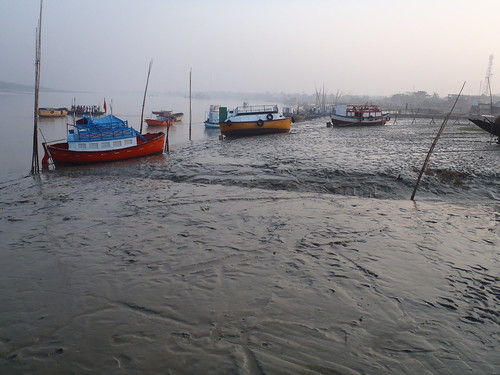
Actually, only part of it is included in Bangladesh, albeit the larger part. A smaller chunk of the forest lie within India's borders, where it is known as the Sundarbans National Park. The Bangladesh part though, is what we are interested in. Home to various flora and fauna, the beast that captures most visitors' imaginations would be the endangered royal bengal tiger, a native of the forests. The tiger, numbering around 300, is the single biggest bengal tiger concentration in the world. Here, as elsewhere, tiger poaching remains a problem, but the Sundarban tigers do pretty well in these freshwater swamps, tiger attacks account for 100-250 (source:Wikipedia) attacks per year. This number is unusually high, and the more aggressive behaviour of the tigers in this region has been attributed to several possible reasons. One of them is apparently due to them drinking the salty water, which makes them slightly crazy, and results in them attacking humans.
And thus, The Sundarbans would have to be one of the highlights of my Bangladesh trip, and prior to leaving Singapore, I arranged for a day tour of the Sundarbans.
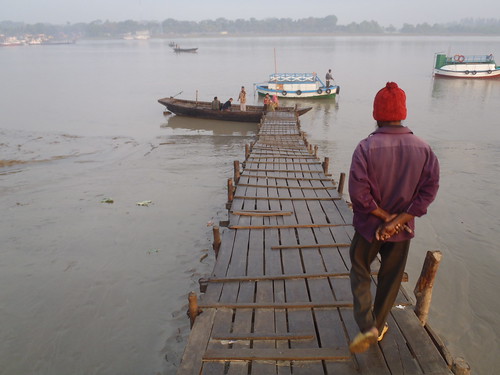
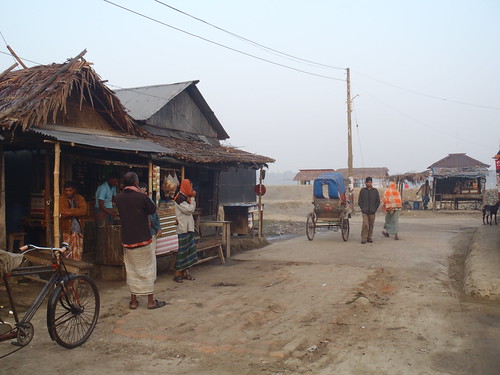
Today morning, I got up at 7am, had a quick cup of locally brewed fresh cha, (which came with free attention from the cha drinking locals) before making my way across the river back to Hotel Pashtur, where I was to meet my guide. There were two of them, and we proceed to get some packed lunch before loading onto the boat. Somewhere along the way, one of the guides went off to another boat, which apparently had more tourists, and I was left with the other. This chap, whose name I didn't clearly get, didn't speak the best English, and I only realised that after we set off.

The boat-man was actually a boat-kid, an overeager young boy named Al-Amin, and his job was to start the engine and steer the boat through the canals. The boat itself was a small seaworthy wooden structure, agile enough to weave around the narrow canals and rigged up enough to plow through the muddy waters of the Sundarbans, chugging away on its noisy engine. I was of course the only passenger on this boat, which would explain why the one day tour was so costly (by Bangladesh standards, 120 USD is a small fortune; for comparison, my hotel last night was 1.50 USD). Ok, most of the cost went to the park entrance fees, the hiring of an armed guard (to protect from tiger attacks, no less!) and other neccessities like the boat rental etc, "and of course the profit margin, which isn't much".
The boat would set off from Mongla port, toward the Karamjal camp, and then towards Habaria camp, and from there make the return trip back to Mongla. It was a serene boat ride, the first part was through a large channel, deep enough for large ships, anchored in the middle, just off Mongla port, ready to set off into the Bay of Bengal. Our little vessel hugged the river bank, and I was treated to the sight of mudflats and a thick expanse of mangrove, leading off from the bank and getting thicker and thicker the further inland you look. It looked a bit, for those of you Singaporeans, like the mangrove swamps you find in Pulau Ubin (Kampung Chek Jawa area), except you need to multiply that area by one billion ^^.
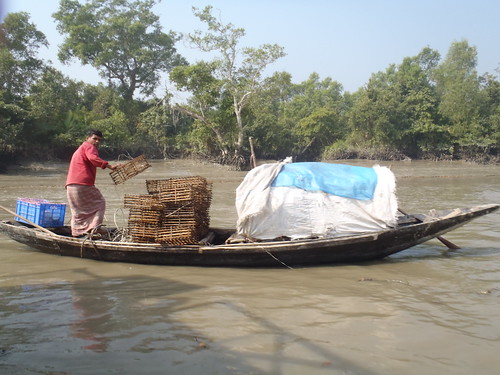
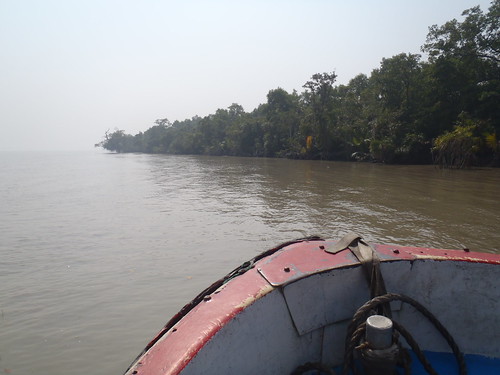

Going deeper into the Sundarbans, I perched myself on the roof of the boat, which resembled a sun-deck. I laid a cushion, and after about 20 minutes of admiring the natural surroundings, proceeded to read my book. I tried holding a conversation with Guide Whose Name I Didn't Catch, And Is Unpronounceable, but gave up since it was too tedious. We passed by several little settlements on the outskirts of the Sundarbans, there were a few thousand living within the Sundarbans, moving around, possibly becoming tiger food once in a while. More interestingly, I read about the honey hunters, men who braved the deadly Sundarbans bees to collect their honey and sell. And then I realised that was the bottled yellow stuff the guy behind the Hotel Pashtur counter was trying to show me. Orh.

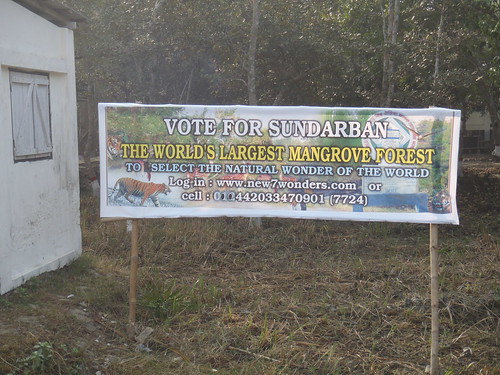
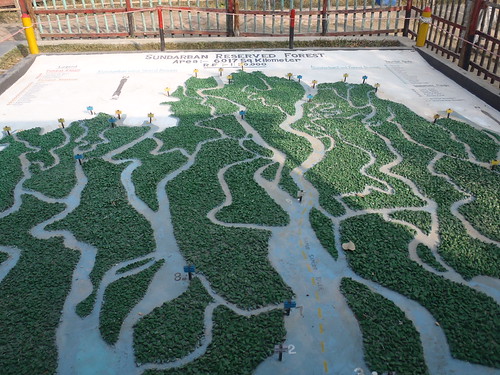
We reached Karamjal camp within the hour, and disembarked. There were plenty of locals here, visitng the Sundarbans as part of a weekend day trip, since today (Saturday) is a non-working day. There was a zoo, or rather a wildlife conservation area, which is sadly, nothing much to get excited about. There were a couple of monkeys in cages, a spotted deer enclosure and many, many baby crocodiles. No tigers, unfortunately, lol. And anyway, I was a better exhibit than the animals. These Bangla tourists and their families were queuing up to take photos of/with me.
Also in Karamjal camp, there was a raised wooden boardwalk that meandered through the mangrove forest, giving the visitor a glimpse of the inland terrain. The boardwalk ended but the path continued. I followed my guide who kept stopping, and using my camera to take photographs of me. Now, for any of you who has traveled anywhere with me, you already know that I hardly take any photographs of myself. Other than one or two pictures for memories and to prove I've been there, I don't really see the point. So it is to my chagrin that the guide kept offering to take my picture. After a while, I just told him upfront that I'd rather take nature, without me inside the photo. He duly obliged, and I get off with a souvenir of 20+ shots of me in various poses modelling in the Sundarban wilds.

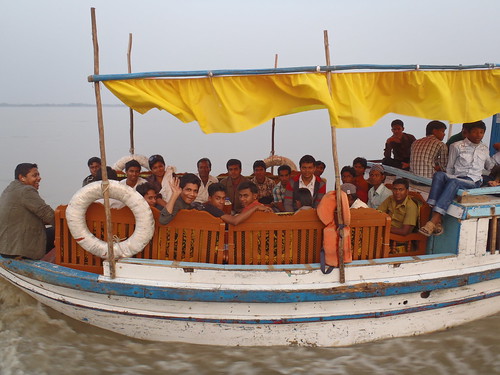
We set off on the boat again, I bade farewell to my legions of adoring Bangladesh fans in Karamjal (hey I can be delusional if I want to, it must the salty water the tigers drink, it gets in the air...) before setting off towards Habaria, the next destination and final stopover point. This was at least a two hour journey, and the initial awe of passing through these waterways had long since subsided. It was getting hot too, so I decided to take a nap. The scenery was similar all the way, and other than a few birds, whose fancy colours I was unable to distinguish since I did not carry binoculars, there weren't any other animals.
I was woken up by my guide. Still woozy and trying to orientate myself, I was told we had reached Habaria. With all the expectation that came along with a two hour trip, it ended up being a bit of a disappointment. From Habaria was where travelers set off towards their 4 day Sundarbans trip, and here was where you would need to pay for the armed guard and also the park fees. (I may be wrong, but I read somewhere while researching the Sundarbans that getting the boat up to Karamjal would not require any park fees or armed guard fees).
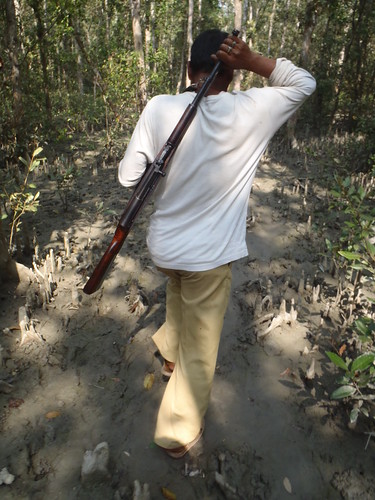
I spent a grand total of 15 minutes following my guide and the bored armed guard into the Habaria undergrowth. We had to stop and turn back when the guide pointed out dried blood on the ground just off the path. He said that the blood was less than 3 days old, and it was not safe to go further, unless I had a death-wish to get mauled by a Bengal tiger. And so, disappointed, but glad I won't be tiger fodder, I made my way back to the campsite, stopping by a gazebo, where I would find a group of other tourists. There were 5 of them, curious mix of 3 Germans, 1 Chinese, 1 Mexican, 1 Brazilian. I learnt that they were a group of students interning at the local Garmin Bank, and having met each other only a week ago, they had decided to go out on this Sundarbans trip together. They offered me some of their packed lunch, and we had some conversation, mainly me asking them about their backgrounds, and them asking me why in the world would a Singaporean go to Bangladesh for a solo holiday destination. It was probably the best part of the day, I realised I missed the friendly banter, and really wondered why I could not have been put on the same boat. After all, I found that my missing guide from earlier in the day was their guide!

After lunch, we retraced our steps back to the moored boat, and began the long journey back to Mongla. I would have loved to go deeper in, and dreamt of setting off from Habaria all the way south till I could see the Bay of Bengal, but that would require at least a 4 day trip. Thinking about it, i would probably die of boredom if I was out 4 days alone, with a guide who doesn't speak English and a boat-kid who's more interested in my flashpacking gear.
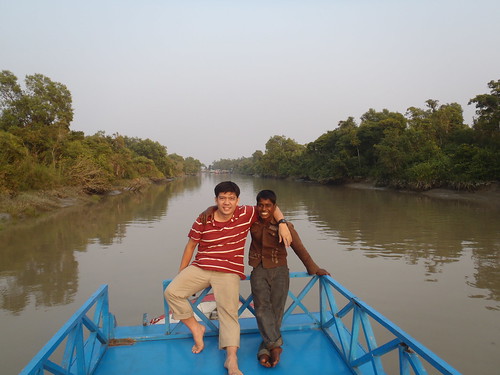
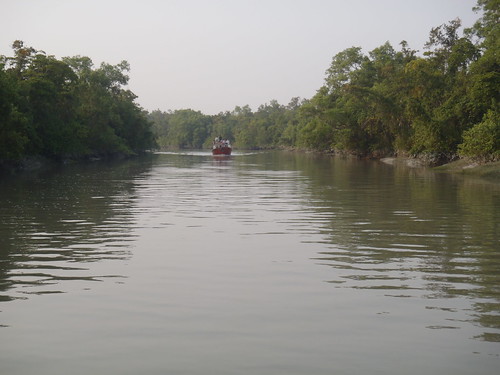
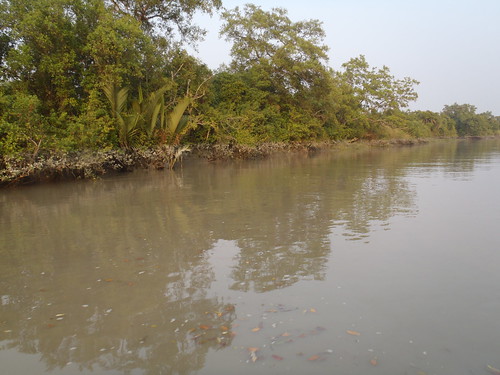
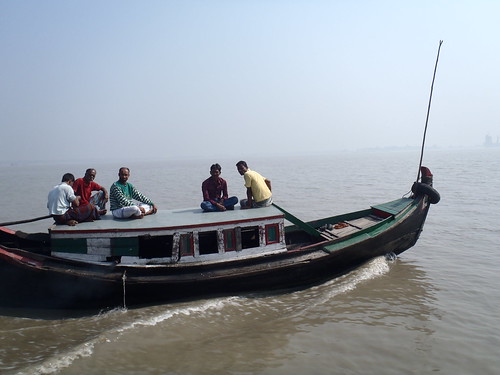
The trip itself was good, I expected to see the beautiful scenery and I did. An added plus was that during the return trip, we detoured a bit and went through some narrow canals near Karamjal. However, on the whole, I found the entire experience quite unprofessional, especially since it came from a proper tour company. It seemed that the standard basic service that was to be accorded to a tourist on a tour was not there. This is probably attributed to my tour guide with the unpronounceable name who doesn't speak good English, who seemed more eager to shepherd me through the entire trip during the trekking bits in Karamjal and Habaria. Also, Al Amin didnt leave me much privacy by sitting on my shoulder while I was typing these entries as well as checking my online maps, and when he started asking for freebies. I wondered how much of the share of what i paid these guys actually got, and how much went to the middlemen who did the liaising online. It seemed to me at least that with the way these two are behaving, they got pittance. Either that or they think im a Dubai prince with a bottomless bank account.
End of trip: It left me strangely unsatisfied, and I looked back and realised that a 1 day trip was simply too short to see anything. A 3 to 4 day trip through the Sundarbans would make more sense, with friends to enjoy time on the roof of the boat. With a 4 day trip, the journey would take you through the entire length of the Sundarbans, and culminate in a visit to the southeastern tip of the forest, aptly named Tiger Point. The day trip I took barely scratched the surface, Karamjal Camp to Habaria Camp was just the appetizer. And too little time was spent in Habaria, no thanks to the tiger blood trails.

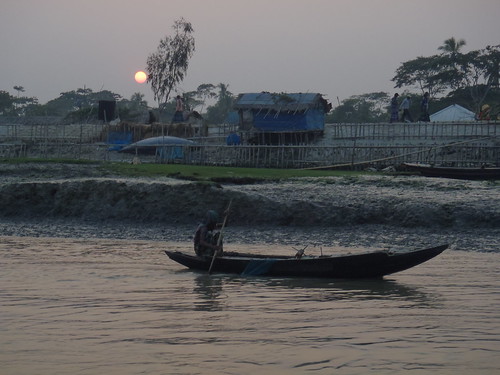
From Mongla, I decided to make my way up north to Khulna. During the long boat ride, I had planned to go up north to Rajshahi, after a recommendation from one of the German exchange students to take the country train. The train sets off early morning from Khulna, and so I took the one hour bus ride that evening into Khulna. Khulna, described in Lonely Planet as a town with a frontier feel, would have been a problem because I reached the bus station at 8pm, with no orientation of the town whatsover. I do hate reaching towns (cities are worse) at night, because of the myriad of uncertainties. At best, I would be overcharged by the cab driver, or CNG over here, for a trip to my hotel. Worse case scenario, I would get mugged or robbed. Fortunately, I would come across more Bangladeshi hospitality. During the bus ride from Mongla to Khulna, I was seated at the front of the bus. As usual, a local youth, Talat Mahmud, came up to seat himself beside me and proceeded to Facebook on his phone. Curiousity eventually got the better of him, and he asked about me. I learnt that Talat is a student in the local college university in Khulna, and we talked a little. When I got off the bus, he accompanied me on a rickshaw to the train station, where I would buy a train ticket to Rajshahi (6.30am intercity train) before we went to the motel I found in LP, Hotel Society. I invited Talat to have dinner with me, but he declined. Between speaking Bengali to get my train ticket for me, and bargaining and even paying for my rickshaw, Talat probably saved me an hour of aimless wondering around Khulna.
I dumped my bag in my room, and went downstairs to get some dinner. Hotel Society was located in a colourful part of Khulna, with many jewelry shops, which made me feel safer walking alone in the street at night. I bought random food to try from the street vendors, packed them and went back to my room to relax. Tomorrow, I would head off to Rajshahi, and from there, make my way to Bogra, the launchpad to my third World Heritage Site, the Sompuri Vihara.
Location: Society Hotel, Khulna,
So everyone starts asking, why Bangladesh? Why not India or Sri Lanka or some other South Asian country? This entry's why. The Sundarbans. A complex network of tidal waterways, mudflats and small islands of salt-tolerant mangrove forests, the Sundarbans is the largest mangrove forest in the world, a UNESCO world heritage site, a finalist in the New 7 Wonders of Nature, in general it's a little piece of awesome within Bangladesh.

Actually, only part of it is included in Bangladesh, albeit the larger part. A smaller chunk of the forest lie within India's borders, where it is known as the Sundarbans National Park. The Bangladesh part though, is what we are interested in. Home to various flora and fauna, the beast that captures most visitors' imaginations would be the endangered royal bengal tiger, a native of the forests. The tiger, numbering around 300, is the single biggest bengal tiger concentration in the world. Here, as elsewhere, tiger poaching remains a problem, but the Sundarban tigers do pretty well in these freshwater swamps, tiger attacks account for 100-250 (source:Wikipedia) attacks per year. This number is unusually high, and the more aggressive behaviour of the tigers in this region has been attributed to several possible reasons. One of them is apparently due to them drinking the salty water, which makes them slightly crazy, and results in them attacking humans.
And thus, The Sundarbans would have to be one of the highlights of my Bangladesh trip, and prior to leaving Singapore, I arranged for a day tour of the Sundarbans.


Today morning, I got up at 7am, had a quick cup of locally brewed fresh cha, (which came with free attention from the cha drinking locals) before making my way across the river back to Hotel Pashtur, where I was to meet my guide. There were two of them, and we proceed to get some packed lunch before loading onto the boat. Somewhere along the way, one of the guides went off to another boat, which apparently had more tourists, and I was left with the other. This chap, whose name I didn't clearly get, didn't speak the best English, and I only realised that after we set off.

The boat-man was actually a boat-kid, an overeager young boy named Al-Amin, and his job was to start the engine and steer the boat through the canals. The boat itself was a small seaworthy wooden structure, agile enough to weave around the narrow canals and rigged up enough to plow through the muddy waters of the Sundarbans, chugging away on its noisy engine. I was of course the only passenger on this boat, which would explain why the one day tour was so costly (by Bangladesh standards, 120 USD is a small fortune; for comparison, my hotel last night was 1.50 USD). Ok, most of the cost went to the park entrance fees, the hiring of an armed guard (to protect from tiger attacks, no less!) and other neccessities like the boat rental etc, "and of course the profit margin, which isn't much".
The boat would set off from Mongla port, toward the Karamjal camp, and then towards Habaria camp, and from there make the return trip back to Mongla. It was a serene boat ride, the first part was through a large channel, deep enough for large ships, anchored in the middle, just off Mongla port, ready to set off into the Bay of Bengal. Our little vessel hugged the river bank, and I was treated to the sight of mudflats and a thick expanse of mangrove, leading off from the bank and getting thicker and thicker the further inland you look. It looked a bit, for those of you Singaporeans, like the mangrove swamps you find in Pulau Ubin (Kampung Chek Jawa area), except you need to multiply that area by one billion ^^.



Going deeper into the Sundarbans, I perched myself on the roof of the boat, which resembled a sun-deck. I laid a cushion, and after about 20 minutes of admiring the natural surroundings, proceeded to read my book. I tried holding a conversation with Guide Whose Name I Didn't Catch, And Is Unpronounceable, but gave up since it was too tedious. We passed by several little settlements on the outskirts of the Sundarbans, there were a few thousand living within the Sundarbans, moving around, possibly becoming tiger food once in a while. More interestingly, I read about the honey hunters, men who braved the deadly Sundarbans bees to collect their honey and sell. And then I realised that was the bottled yellow stuff the guy behind the Hotel Pashtur counter was trying to show me. Orh.



We reached Karamjal camp within the hour, and disembarked. There were plenty of locals here, visitng the Sundarbans as part of a weekend day trip, since today (Saturday) is a non-working day. There was a zoo, or rather a wildlife conservation area, which is sadly, nothing much to get excited about. There were a couple of monkeys in cages, a spotted deer enclosure and many, many baby crocodiles. No tigers, unfortunately, lol. And anyway, I was a better exhibit than the animals. These Bangla tourists and their families were queuing up to take photos of/with me.
Also in Karamjal camp, there was a raised wooden boardwalk that meandered through the mangrove forest, giving the visitor a glimpse of the inland terrain. The boardwalk ended but the path continued. I followed my guide who kept stopping, and using my camera to take photographs of me. Now, for any of you who has traveled anywhere with me, you already know that I hardly take any photographs of myself. Other than one or two pictures for memories and to prove I've been there, I don't really see the point. So it is to my chagrin that the guide kept offering to take my picture. After a while, I just told him upfront that I'd rather take nature, without me inside the photo. He duly obliged, and I get off with a souvenir of 20+ shots of me in various poses modelling in the Sundarban wilds.


We set off on the boat again, I bade farewell to my legions of adoring Bangladesh fans in Karamjal (hey I can be delusional if I want to, it must the salty water the tigers drink, it gets in the air...) before setting off towards Habaria, the next destination and final stopover point. This was at least a two hour journey, and the initial awe of passing through these waterways had long since subsided. It was getting hot too, so I decided to take a nap. The scenery was similar all the way, and other than a few birds, whose fancy colours I was unable to distinguish since I did not carry binoculars, there weren't any other animals.
I was woken up by my guide. Still woozy and trying to orientate myself, I was told we had reached Habaria. With all the expectation that came along with a two hour trip, it ended up being a bit of a disappointment. From Habaria was where travelers set off towards their 4 day Sundarbans trip, and here was where you would need to pay for the armed guard and also the park fees. (I may be wrong, but I read somewhere while researching the Sundarbans that getting the boat up to Karamjal would not require any park fees or armed guard fees).

I spent a grand total of 15 minutes following my guide and the bored armed guard into the Habaria undergrowth. We had to stop and turn back when the guide pointed out dried blood on the ground just off the path. He said that the blood was less than 3 days old, and it was not safe to go further, unless I had a death-wish to get mauled by a Bengal tiger. And so, disappointed, but glad I won't be tiger fodder, I made my way back to the campsite, stopping by a gazebo, where I would find a group of other tourists. There were 5 of them, curious mix of 3 Germans, 1 Chinese, 1 Mexican, 1 Brazilian. I learnt that they were a group of students interning at the local Garmin Bank, and having met each other only a week ago, they had decided to go out on this Sundarbans trip together. They offered me some of their packed lunch, and we had some conversation, mainly me asking them about their backgrounds, and them asking me why in the world would a Singaporean go to Bangladesh for a solo holiday destination. It was probably the best part of the day, I realised I missed the friendly banter, and really wondered why I could not have been put on the same boat. After all, I found that my missing guide from earlier in the day was their guide!

After lunch, we retraced our steps back to the moored boat, and began the long journey back to Mongla. I would have loved to go deeper in, and dreamt of setting off from Habaria all the way south till I could see the Bay of Bengal, but that would require at least a 4 day trip. Thinking about it, i would probably die of boredom if I was out 4 days alone, with a guide who doesn't speak English and a boat-kid who's more interested in my flashpacking gear.




The trip itself was good, I expected to see the beautiful scenery and I did. An added plus was that during the return trip, we detoured a bit and went through some narrow canals near Karamjal. However, on the whole, I found the entire experience quite unprofessional, especially since it came from a proper tour company. It seemed that the standard basic service that was to be accorded to a tourist on a tour was not there. This is probably attributed to my tour guide with the unpronounceable name who doesn't speak good English, who seemed more eager to shepherd me through the entire trip during the trekking bits in Karamjal and Habaria. Also, Al Amin didnt leave me much privacy by sitting on my shoulder while I was typing these entries as well as checking my online maps, and when he started asking for freebies. I wondered how much of the share of what i paid these guys actually got, and how much went to the middlemen who did the liaising online. It seemed to me at least that with the way these two are behaving, they got pittance. Either that or they think im a Dubai prince with a bottomless bank account.
End of trip: It left me strangely unsatisfied, and I looked back and realised that a 1 day trip was simply too short to see anything. A 3 to 4 day trip through the Sundarbans would make more sense, with friends to enjoy time on the roof of the boat. With a 4 day trip, the journey would take you through the entire length of the Sundarbans, and culminate in a visit to the southeastern tip of the forest, aptly named Tiger Point. The day trip I took barely scratched the surface, Karamjal Camp to Habaria Camp was just the appetizer. And too little time was spent in Habaria, no thanks to the tiger blood trails.


From Mongla, I decided to make my way up north to Khulna. During the long boat ride, I had planned to go up north to Rajshahi, after a recommendation from one of the German exchange students to take the country train. The train sets off early morning from Khulna, and so I took the one hour bus ride that evening into Khulna. Khulna, described in Lonely Planet as a town with a frontier feel, would have been a problem because I reached the bus station at 8pm, with no orientation of the town whatsover. I do hate reaching towns (cities are worse) at night, because of the myriad of uncertainties. At best, I would be overcharged by the cab driver, or CNG over here, for a trip to my hotel. Worse case scenario, I would get mugged or robbed. Fortunately, I would come across more Bangladeshi hospitality. During the bus ride from Mongla to Khulna, I was seated at the front of the bus. As usual, a local youth, Talat Mahmud, came up to seat himself beside me and proceeded to Facebook on his phone. Curiousity eventually got the better of him, and he asked about me. I learnt that Talat is a student in the local college university in Khulna, and we talked a little. When I got off the bus, he accompanied me on a rickshaw to the train station, where I would buy a train ticket to Rajshahi (6.30am intercity train) before we went to the motel I found in LP, Hotel Society. I invited Talat to have dinner with me, but he declined. Between speaking Bengali to get my train ticket for me, and bargaining and even paying for my rickshaw, Talat probably saved me an hour of aimless wondering around Khulna.
I dumped my bag in my room, and went downstairs to get some dinner. Hotel Society was located in a colourful part of Khulna, with many jewelry shops, which made me feel safer walking alone in the street at night. I bought random food to try from the street vendors, packed them and went back to my room to relax. Tomorrow, I would head off to Rajshahi, and from there, make my way to Bogra, the launchpad to my third World Heritage Site, the Sompuri Vihara.
Labels:
Bangladesh,
Khulna,
Mongla,
Sundarbans
Saturday, February 12, 2011
Day 2 – A warrior-saints legacy – The historic mosque city of Bagerhat
Date of log: 04 Feb 2011, 10pm
Location: In a room in the Hotel Singapore, Mongla, Bangladesh
Yes, the name of the hotel I'm spending the night in is Hotel Singapore, though the hotel itself doesn't do Singapore much justice. It is a simple affair, basic rooms with stained walls, and priced at 150 taka you cant really complain. Located in Mongla, the set-off point for my day long trip to the Sundarbans tomorrow.
Started off the day on the Rocket, which reached Hularhat station, located in Pirojpur district at around 930 am in the morning. It was a good nights rest in the crew's cabin, despite being a little cold. The early morning mist obscured both banks of the river, but through the mist I still could see the fishermen out in their little sampan like boats for the days catch. The locals rate freshwater fish more highly than the sea-water variety.
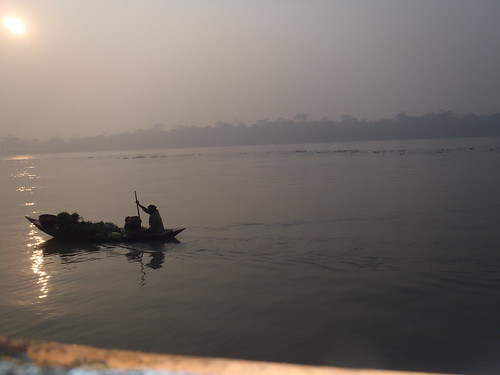
So there's a local guy, Jasim on the boat, who's an aircraft engineer. He approaches me and strikes up a conversation. He's going back over the weekend to see his family, and invites me to visit him. I politely decline (remember i have 5 days to blitz through everything). He speaks good English, and asks me where I am going. We talk for a little while, during which time I learn a little bit more about Bangladesh, the poverty, the aspirations of a nation.He also tells me to avoid any food that anyone offers me.
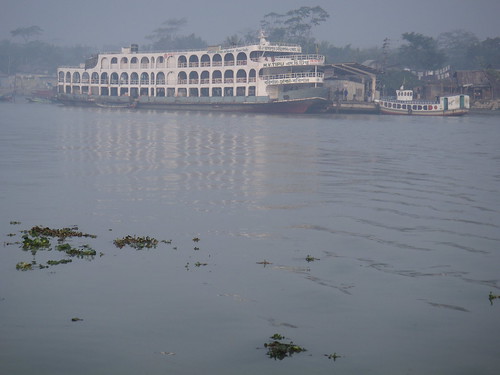
In the course of the next few days, i would meet many a local who shows great interest in the foreigner. Most of them start to surround me and gawk, each time i stand around in any public place for a period of time. It's worse for the ang mohs, since I'm still Asian. A smile normally gets a return smile, and they leave me alone. There's a few of the educated types, who speak English, and would love nothing better than to get to know the foreigner, asking him which country he comes from, his job, his marital status and purpose of visit. They are genuinely interested and very helpful too, there is usually one who comes up to sit next to me in the bus, for example, and offers directions. Without their help, I would probably take much longer to find my way around. Most of them will offer their emails, phone numbers and one even offered me his passport photo. So Alim, Jassim, Talat Mahmud, Halim Nazrul and M.A.Matin, thank you for your help in advance, sorry i gave out my standard alternate email that I never bother to check, and if you're reading this, do drop me a comment or message. And as per what you say, "Wish you better future & God bless you. Thank you."
Getting off the Rocket to the Bangladesh countryside proved to be an experience in itself. Outside of the city, I was lost and it would be hard to find anyone who understood me. Luckily Jasim was there, we took a Tempo, which is something like a shared Tuk tuk, and while he got off halfway, he made sure that the driver brought me to the Pirojpur bus stop. Oh and he paid for my ride as well.
The country buses. Ran down yet functional, the idea is to squeeze in as many as possible. Women sit up front, near the driver, and foreign tourists like me get placed somewhere at the front, where it's "safer". There's always the driver, and then there's the conductor, who's job is to collect the fares from the passengers. His job is also to lean out the door and call out the destination. However, his third function is the most important. He acts as the side mirror for the bus driver. He goes "CLEAR! CLEAR!" or at least something like that, and makes sure the bus doesn't get into an accident. His function is even more critical on my bus, since the side mirror is busted!
So, buses travel on roads that are too narrow. There's only one lane for each direction, and scarcely any road shoulder. When a bus tries to overtake, it definitely needs to cut into the oncoming lane. And how they do it! With pompous horning, the driver will annoy the vehicle in front till they slow down, the driver will then swerve out and back in, all the while with heavy traffic coming from the opposite direction. It was like a case of "Chicken", with the buses always coming out tops because the oncoming CNGs won't stand a chance. Someone here really needs to consider wider roads, at least provide an additional half lane for vehicles to shift to the left to allow another to overtake.
I reached Bagerhat at noon, and took a moment to get my bearings. Lunch was rice, or "bhat" and fried egg curry, fish in curry. All good. Then one of the rickshaw wallahs pulled up near me and asked me my destination. I arranged a price with him to Bagerhat's ruins (50 taka). This fellow was to be the bane of my day. I initially wanted a one way trip, but he insisted on waiting for me, so I let him. The agreed return trip was 100 taka, but he argued for 200 taka at the end of the whole ride, citing waiting time and extras. I was pretty pissed and refused to give in, some other locals joined the commotion we create and went "give him the money, he's a poor man" etc. In the end I just gave him the money. No point spoiling the rest of my stay for 2 SGD. Moral of the story: Don't take the these rickshaw-wallahs, cab drivers, whatever, that come up to you. Always pick your own. Heck, actually, I already knew that, but I didn't do what i preached.
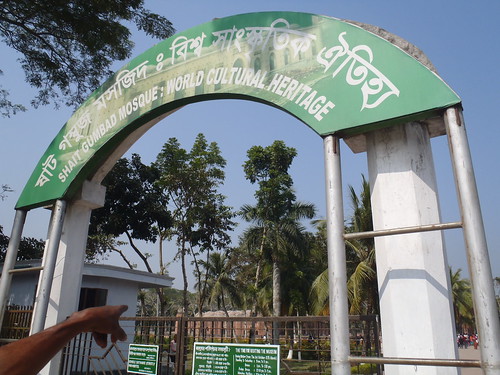
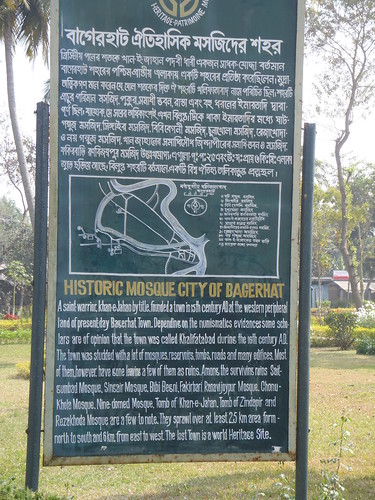
Ok. Let's go on to the main event for today, Bagerhat's historic mosque city is a group of 15th century structures with the same architecture, founded during the pre-Mughal period by a warrior-saint Khan Jahan. Also known as 'Khalifatabad', it is one of three in Bangladesh designated by UNESCO as a world heritage site. The main structures of note are the Shait Gumbad Mosque, also known as the 60 domed mosque, on account of the (actually more than) 60 domes found on the roof and the Khan Jahan's mausoleum. Along with these two structures are a score of various mosques in various states of (dis)repair. Tangled in the undergrowth, some are more well preserved than others, but the defining characteristic for me are the number of domes, ranging from 1 to the 60 on .Besides the Shait Gumbad Mosque, and it's surrounding smaller mosques, there is also the tomb of Khan Jahan, a single domed structure that serves as a pilgrimage site for locals to pay their respects to an important man in Bangladeshi history. More information about the Mosque City of Bagerhat can be found on http://whc.unesco.org/en/list/321
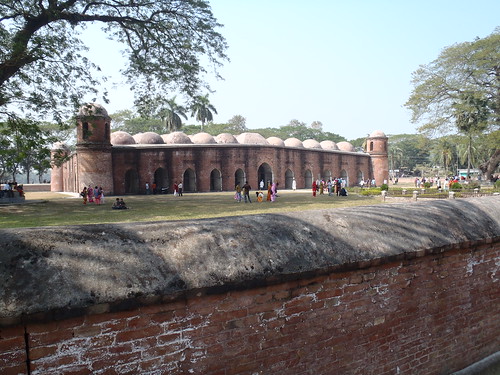
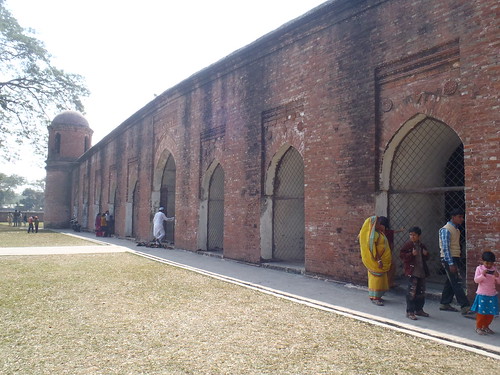
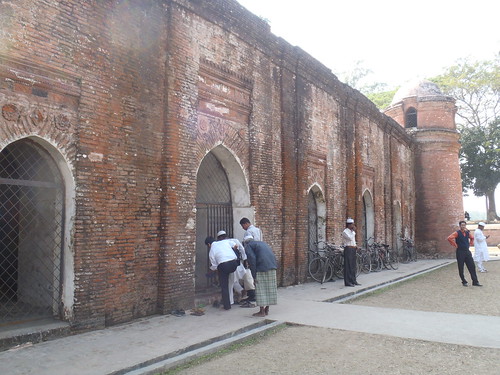
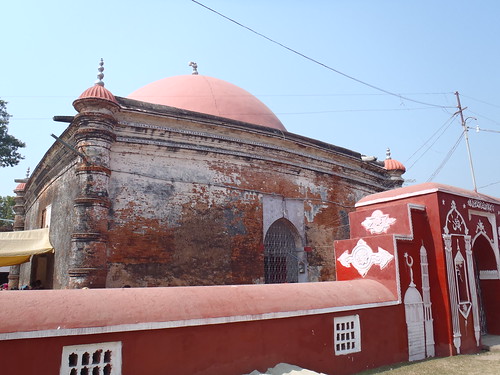
It was a friday afternoon, which here in Bangladesh meant that it was a public holiday. The more pious amongst the locals were doing their afternoon friday prayers at the Shait Gumbad mosque. The rest, and the Hindus, were there for a picnic. Besides the mosques and multi-domed structures, the heritage site was also known for its dighis or ponds, possibly for irrigation, created by the multi-talented Shah Jahan when he conquered this area. The atmosphere was very family friendly, walking around the edges of the pond (actually pond is an understatement, the dighis were huge, 200 to 300m long rectangular ponds. There's one section near the Khan Jahan tomb where people are washing in the pond to absolve themselves of sin. As usual, I was the subject of attention, with everyone "you are from Singapore? Can i take your picture?" being very interested in the foreign traveller who goes to Bangladesh as a tourist.
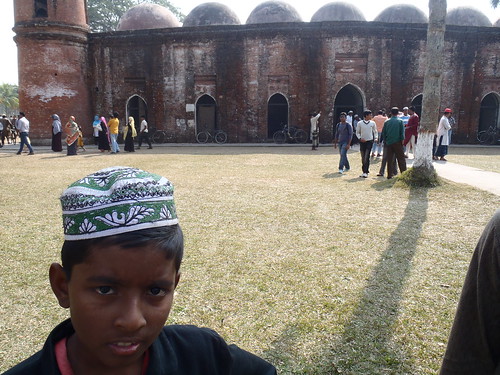
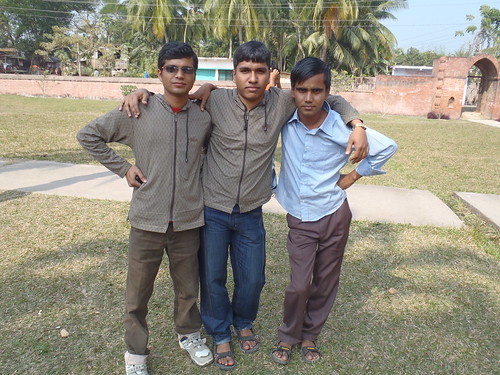
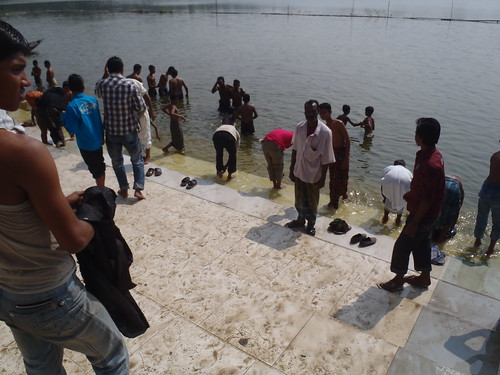


Some more shots of the interior of Shait Gumbad Mosque.
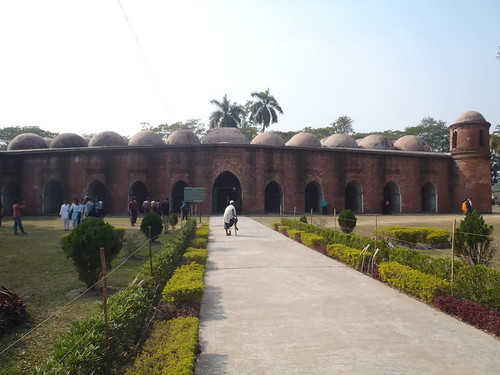
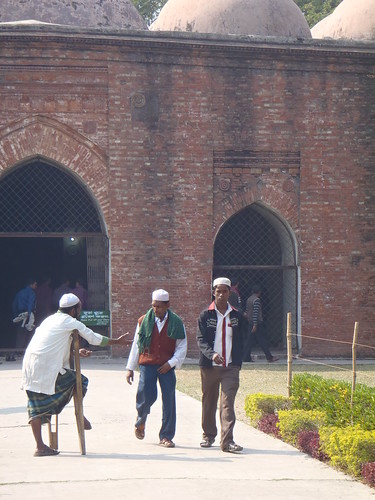
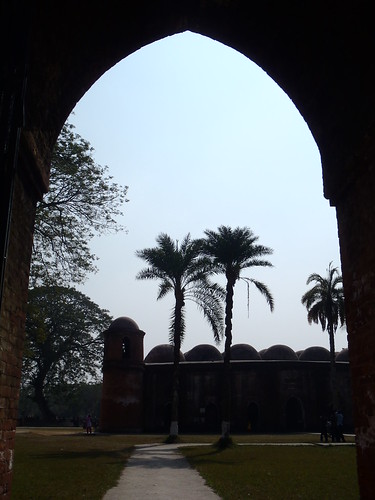

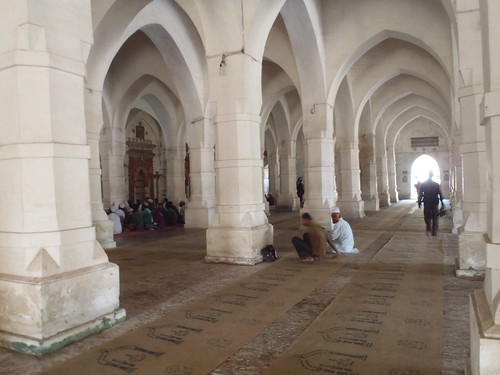
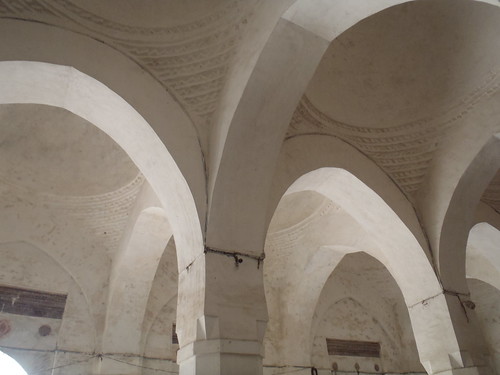
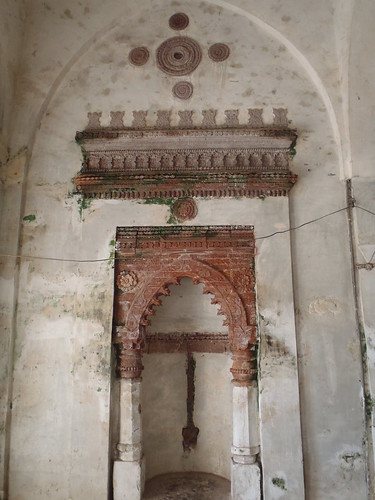
On the way back to Bagerhat town by rickshaw, we detoured to what seemed to me a temple. Since my rickshaw wallah spoke no English, and the temple was devoid of any signs that I could understand, I was left to guess as to the purpose and origin of the temple. It's pretty well kept and there's a boy (who again doesn't speak English) who i think is the groundskeeper or his son. He let me look around and take pictures. I think based on the symbols that I saw, it would seem that it is a combination of different faiths. In the middle is the Hindu Aum, then clockwise is the Muslim star and crescent, the Christian cross, the Jewish star of David, what I think looks like the Siokh Khanda symbol, the Buddhist Dharma wheel and the Swastika, which is probably Jainism. I initially thought that it could be a Baha'i temple, but then it is missing the nine pointed star, and I can't find Taoism and Shinto anywhere. Also, in the photo, the Aum is the central symbol, so that might mean something.
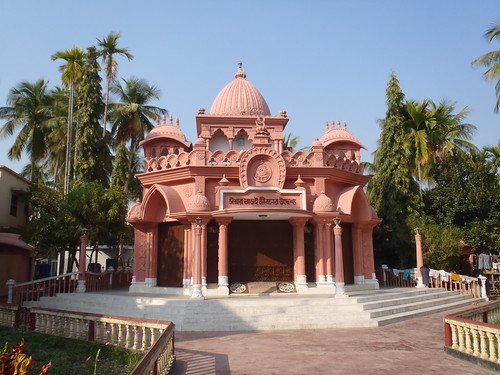
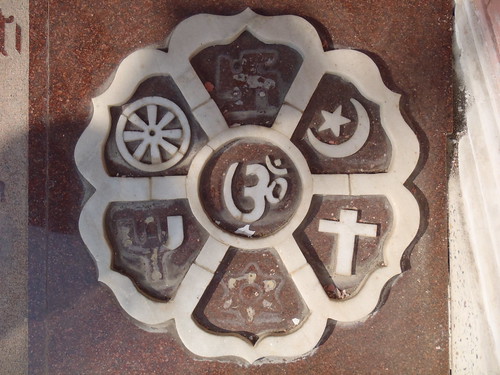
From Bagerhat, I took the bus to the port town of Mongla, which is barely 5km away from The Sundarbans, the largest mangrove forest in the world, and my next destination. The bus to Mongla was a 3 hour bus ride which meant i arrived in Mongla late in the evening at around 8pm. I could not really fathom why the bus ride took 3 hours, since in my guide book it was supposed to be a 1hour plus ride.
Mongla. Met a Mr Ferdaus who is the front desk manager of the Government owned Pashtur hotel. Mahmud from back in Dhaka had linked us up and he would help me with the arrangements for tomorrows's Sundarban trip. Rooms at the Pashtur was 900 taka, but normal rooms were full, only A/C rooms (1600 taka) were available. I was already half-shivering and didn't need A/C so i did the 2 taka boat ride (will move when they get 20 people, or you can pay for the entire boat 40 taka to move you across, 40 taka is less than 1 SGD) across the river, to find, surprise surprise: Hotel Singapore.
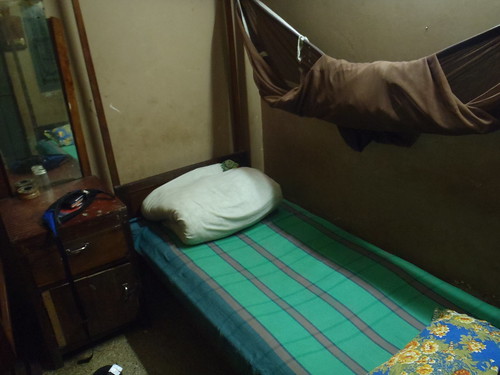
Hotel Singapore is a 150 taka (i think) basic accomodations with stained walls, a simple bed and toilet set up. It is clean though, and quite sufficient for the traveler who just needs a place to plop down his bag and stay the night. I went out to look for some dinner, this Bangla freshwater fish curry dish is starting to grow on me, before going back to my room for an early night. Tomorrow: An entire day out on boat along the canals of the Sundarbans.
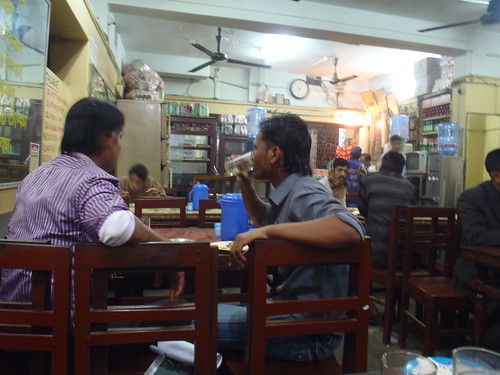

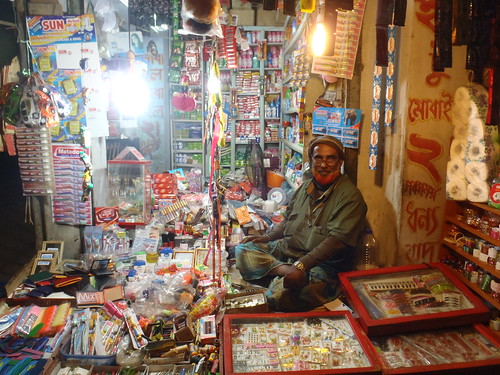
Original post: http://furiouspanda.blogspot.com
More photos at http://www.flickr.com/photos/morphred/
Location: In a room in the Hotel Singapore, Mongla, Bangladesh
Yes, the name of the hotel I'm spending the night in is Hotel Singapore, though the hotel itself doesn't do Singapore much justice. It is a simple affair, basic rooms with stained walls, and priced at 150 taka you cant really complain. Located in Mongla, the set-off point for my day long trip to the Sundarbans tomorrow.
Started off the day on the Rocket, which reached Hularhat station, located in Pirojpur district at around 930 am in the morning. It was a good nights rest in the crew's cabin, despite being a little cold. The early morning mist obscured both banks of the river, but through the mist I still could see the fishermen out in their little sampan like boats for the days catch. The locals rate freshwater fish more highly than the sea-water variety.

So there's a local guy, Jasim on the boat, who's an aircraft engineer. He approaches me and strikes up a conversation. He's going back over the weekend to see his family, and invites me to visit him. I politely decline (remember i have 5 days to blitz through everything). He speaks good English, and asks me where I am going. We talk for a little while, during which time I learn a little bit more about Bangladesh, the poverty, the aspirations of a nation.He also tells me to avoid any food that anyone offers me.

In the course of the next few days, i would meet many a local who shows great interest in the foreigner. Most of them start to surround me and gawk, each time i stand around in any public place for a period of time. It's worse for the ang mohs, since I'm still Asian. A smile normally gets a return smile, and they leave me alone. There's a few of the educated types, who speak English, and would love nothing better than to get to know the foreigner, asking him which country he comes from, his job, his marital status and purpose of visit. They are genuinely interested and very helpful too, there is usually one who comes up to sit next to me in the bus, for example, and offers directions. Without their help, I would probably take much longer to find my way around. Most of them will offer their emails, phone numbers and one even offered me his passport photo. So Alim, Jassim, Talat Mahmud, Halim Nazrul and M.A.Matin, thank you for your help in advance, sorry i gave out my standard alternate email that I never bother to check, and if you're reading this, do drop me a comment or message. And as per what you say, "Wish you better future & God bless you. Thank you."
Getting off the Rocket to the Bangladesh countryside proved to be an experience in itself. Outside of the city, I was lost and it would be hard to find anyone who understood me. Luckily Jasim was there, we took a Tempo, which is something like a shared Tuk tuk, and while he got off halfway, he made sure that the driver brought me to the Pirojpur bus stop. Oh and he paid for my ride as well.
The country buses. Ran down yet functional, the idea is to squeeze in as many as possible. Women sit up front, near the driver, and foreign tourists like me get placed somewhere at the front, where it's "safer". There's always the driver, and then there's the conductor, who's job is to collect the fares from the passengers. His job is also to lean out the door and call out the destination. However, his third function is the most important. He acts as the side mirror for the bus driver. He goes "CLEAR! CLEAR!" or at least something like that, and makes sure the bus doesn't get into an accident. His function is even more critical on my bus, since the side mirror is busted!
So, buses travel on roads that are too narrow. There's only one lane for each direction, and scarcely any road shoulder. When a bus tries to overtake, it definitely needs to cut into the oncoming lane. And how they do it! With pompous horning, the driver will annoy the vehicle in front till they slow down, the driver will then swerve out and back in, all the while with heavy traffic coming from the opposite direction. It was like a case of "Chicken", with the buses always coming out tops because the oncoming CNGs won't stand a chance. Someone here really needs to consider wider roads, at least provide an additional half lane for vehicles to shift to the left to allow another to overtake.
I reached Bagerhat at noon, and took a moment to get my bearings. Lunch was rice, or "bhat" and fried egg curry, fish in curry. All good. Then one of the rickshaw wallahs pulled up near me and asked me my destination. I arranged a price with him to Bagerhat's ruins (50 taka). This fellow was to be the bane of my day. I initially wanted a one way trip, but he insisted on waiting for me, so I let him. The agreed return trip was 100 taka, but he argued for 200 taka at the end of the whole ride, citing waiting time and extras. I was pretty pissed and refused to give in, some other locals joined the commotion we create and went "give him the money, he's a poor man" etc. In the end I just gave him the money. No point spoiling the rest of my stay for 2 SGD. Moral of the story: Don't take the these rickshaw-wallahs, cab drivers, whatever, that come up to you. Always pick your own. Heck, actually, I already knew that, but I didn't do what i preached.


Ok. Let's go on to the main event for today, Bagerhat's historic mosque city is a group of 15th century structures with the same architecture, founded during the pre-Mughal period by a warrior-saint Khan Jahan. Also known as 'Khalifatabad', it is one of three in Bangladesh designated by UNESCO as a world heritage site. The main structures of note are the Shait Gumbad Mosque, also known as the 60 domed mosque, on account of the (actually more than) 60 domes found on the roof and the Khan Jahan's mausoleum. Along with these two structures are a score of various mosques in various states of (dis)repair. Tangled in the undergrowth, some are more well preserved than others, but the defining characteristic for me are the number of domes, ranging from 1 to the 60 on .Besides the Shait Gumbad Mosque, and it's surrounding smaller mosques, there is also the tomb of Khan Jahan, a single domed structure that serves as a pilgrimage site for locals to pay their respects to an important man in Bangladeshi history. More information about the Mosque City of Bagerhat can be found on http://whc.unesco.org/en/list/321




It was a friday afternoon, which here in Bangladesh meant that it was a public holiday. The more pious amongst the locals were doing their afternoon friday prayers at the Shait Gumbad mosque. The rest, and the Hindus, were there for a picnic. Besides the mosques and multi-domed structures, the heritage site was also known for its dighis or ponds, possibly for irrigation, created by the multi-talented Shah Jahan when he conquered this area. The atmosphere was very family friendly, walking around the edges of the pond (actually pond is an understatement, the dighis were huge, 200 to 300m long rectangular ponds. There's one section near the Khan Jahan tomb where people are washing in the pond to absolve themselves of sin. As usual, I was the subject of attention, with everyone "you are from Singapore? Can i take your picture?" being very interested in the foreign traveller who goes to Bangladesh as a tourist.





Some more shots of the interior of Shait Gumbad Mosque.







On the way back to Bagerhat town by rickshaw, we detoured to what seemed to me a temple. Since my rickshaw wallah spoke no English, and the temple was devoid of any signs that I could understand, I was left to guess as to the purpose and origin of the temple. It's pretty well kept and there's a boy (who again doesn't speak English) who i think is the groundskeeper or his son. He let me look around and take pictures. I think based on the symbols that I saw, it would seem that it is a combination of different faiths. In the middle is the Hindu Aum, then clockwise is the Muslim star and crescent, the Christian cross, the Jewish star of David, what I think looks like the Siokh Khanda symbol, the Buddhist Dharma wheel and the Swastika, which is probably Jainism. I initially thought that it could be a Baha'i temple, but then it is missing the nine pointed star, and I can't find Taoism and Shinto anywhere. Also, in the photo, the Aum is the central symbol, so that might mean something.


From Bagerhat, I took the bus to the port town of Mongla, which is barely 5km away from The Sundarbans, the largest mangrove forest in the world, and my next destination. The bus to Mongla was a 3 hour bus ride which meant i arrived in Mongla late in the evening at around 8pm. I could not really fathom why the bus ride took 3 hours, since in my guide book it was supposed to be a 1hour plus ride.
Mongla. Met a Mr Ferdaus who is the front desk manager of the Government owned Pashtur hotel. Mahmud from back in Dhaka had linked us up and he would help me with the arrangements for tomorrows's Sundarban trip. Rooms at the Pashtur was 900 taka, but normal rooms were full, only A/C rooms (1600 taka) were available. I was already half-shivering and didn't need A/C so i did the 2 taka boat ride (will move when they get 20 people, or you can pay for the entire boat 40 taka to move you across, 40 taka is less than 1 SGD) across the river, to find, surprise surprise: Hotel Singapore.

Hotel Singapore is a 150 taka (i think) basic accomodations with stained walls, a simple bed and toilet set up. It is clean though, and quite sufficient for the traveler who just needs a place to plop down his bag and stay the night. I went out to look for some dinner, this Bangla freshwater fish curry dish is starting to grow on me, before going back to my room for an early night. Tomorrow: An entire day out on boat along the canals of the Sundarbans.



Original post: http://furiouspanda.blogspot.com
More photos at http://www.flickr.com/photos/morphred/
Labels:
Bagerhat,
Bangladesh,
Mongla,
Pirojpur
Subscribe to:
Posts (Atom)